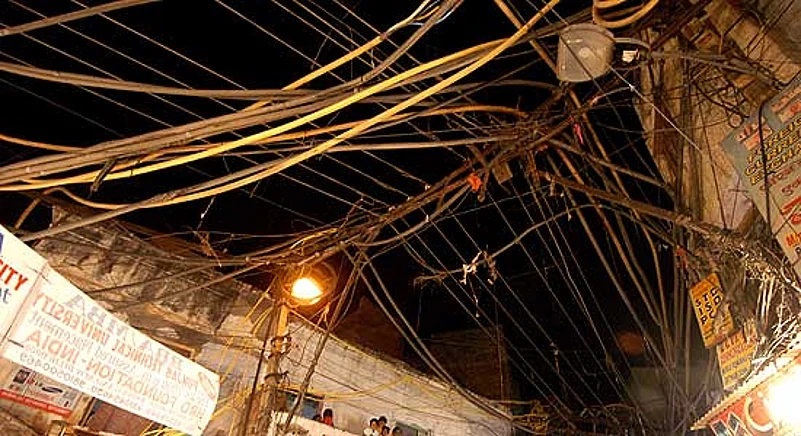People don’t seem to realise that part of the electricity they consume costs over Rs 11 per unit simply because someone is making a quick buck. Unscrupulous traders are selling to distribution companies at about Rs 7 per unit. After adding distribution costs and transmission and distribution losses of 30 per cent, the delivered cost crosses Rs 11. Such profiteering in an essential commodity like electricity would have normally attracted strong reactions but it has not happened primarily because distribution companies blend this high-cost electricity with cheaper supplies from dedicated sources and the impact is thus diffused. This would, however, lead to ever-higher consumer tariffs with each passing year.
According to the latest Economic Survey, traders sold 2,192 crore units in 2008-09 at an average price of Rs 7.29 per unit as compared to Rs 3.14 in 2005-06, implying a rise of 132 per cent in just three years. In addition, over 2,150 crore units were ‘traded’ through Unscheduled Interchange (UI) at an average price of Rs 5.37 per unit. In the last eight months of 2008-09, two power exchanges sold about 270 crore units at an average price of Rs 7.49 per unit. The total payments for ‘traded power’ thus aggregated about Rs 30,000 crore in 2008-09 and this amount is sure to increase in 2009-10. Assuming an average generation cost of Rs 2 per unit, profiteering exceeded a whopping Rs 20,000 crore in 2008-09 alone. All of it would be passed on to the hapless common man, who also bears the brunt of power cuts.

This exploitation occurs because the consumer is hostage to an interconnected chain of monopolies. There is no power producer in India who has open access to any consumer, howsoever large. In other words, no consumer buys electricity from a competing producer or supplier. He can buy from none other than a state-owned distribution company. Even where privatisation of distribution has occurred, such as in Orissa and Delhi, public monopolies have been substituted by private ones. The scourge of monopolies has virtually decimated the power sector in India and the peak shortage increased from 11.2 per cent to 16.6 per cent over a five-year period ending 2007-08.
State-owned monopolies neither have the credit-worthiness to raise the required capital nor the ability to build the additional capacity necessary for meeting the rising demand. Nor can they inspire sufficient confidence to attract private investment, which accounts for only about 28 per cent of the total investment, including captive generation. As a result, about 40 per cent of the households remain without access to electricity even after six decades of Independence and those who do get electricity suffer from poor quality of supply. The loss in terms of productivity, quality of life, employment and incomes is enormous by any standards, and diminishes India’s hope to be at the forefront of emerging economic powers.
In contrast, a single private company has provided mobile phone connections to no less than ten crore customers across India, and it is not a monopoly as it has four strong competitors. Every company can connect its subscribers to any other telephone through open access to the networks. This has created unprecedented opportunities, with about 65 per cent of the total investment coming from the private sector. As a result, teledensity has increased from 7 per cent in March 2004 to 37 per cent by March 2009 when mobile connections exceeded 42.8 crore. Over a crore new connections are added every month while call charges in India are, perhaps, the lowest in the world. Thanks to competition and open access, the telecom revolution has reached the aam admi—not just as rhetoric, but in reality!
The debate on introducing competition in the power sector began in February 2000 when the draft Electricity Bill was presented at the chief ministers’ conference chaired by the prime minister. An extensive debate within and outside Parliament led to enactment of the Electricity Act 2003, which provides the legal framework for competition and open access, much the same way as telecom does. Yet, no state has enabled open access to a single consumer during the past six years and the regulatory commissions have only been mute spectators. If there can be a good example of contempt of Parliament, this is it.
The electricity sold by power producers is only purchased by 20-odd state-owned utilities in what can best be described as a ‘non-market’. Power-surplus states are ‘exporting’ to deficit states at exorbitant prices in violation of the constitutional provisions that prohibit barriers to inter-state trade. Electricity is, perhaps, the only commodity market where all buyers are state-owned, most are loss-making. In an environment of shortages, these state-owned entities are driven more by political impulses than economic considerations. What is being passed off in the name of ‘trading’ and ‘markets’ is no more than a camouflaged vehicle for rent-seeking of unprecedented proportions.
If all mobile users were to get their connections only from a state-owned monopoly, the telecom sector would have resembled the power sector. Remember how hard it was during the pre-1990s to get a telephone connection? A vibrant market got created only after competing players were allowed to access millions of potential consumers. Air travel went the same way; competition led to massive investment in expansion, besides reducing fares to less than half. As a result, the annual growth rate of air traffic exceeded 20 per cent for several years. In contrast, denial of open access to electricity consumers has meant the absence of a market, which in turn has led to scarcity of investment. If investors must remain confined to a handful of loss-making state-owned monopolies, they would rather venture elsewhere. If only open access to consumers were provided in pursuance of the Electricity Act, we would have seen a vibrant electricity market, leading to a lot more growth and welfare.
In 1990, the UK provided open access to all bulk consumers of one megawatt. This was gradually extended to smaller consumers and went right up to the household by 1999. Most of the developed world has followed this path over time. The electricity markets so created have benefited the consumers, suppliers and producers, and the respective economies too. For example, a household in London can choose from among twelve competing suppliers of electricity. In India, even if you consume 5 megawatts, you can only buy from the area monopoly, your entitlement to choice under the Electricity Act notwithstanding.
The unmistakable objective of competition and regulation is to protect consumer interests. In the power sector, however, both seem to have deserted the common man. Competition is completely absent as no consumer of electricity is able to exercise any choice in the face of monopolies. As for regulation, the all-pervasive apathy of regulatory commissions to rampant profiteering in bulk supply suggests they have been captured by entrenched interests. No less than the Central Electricity Regulatory Commission has recently decreed that the price cap for bulk power will be Rs 8 per unit, thus legitimising sales up to that exorbitant ceiling in the name of “ensuring reasonable prices”. A regulated wholesale price of 17 cents per unit would be a world record of sorts! In comparison, Enron was an angel at 7 cents!
Incumbents in the power sector argue that India is not yet mature for open access and the examples of telecom in India or the power sector in developed countries are irrelevant. They forget India is in the select club of nuclear powers, it is a software leader and its growth in the telecom sector is second to none. It has enough entrepreneurs and capital for turning around the power sector if only the state-owned utilities would let go of their monopoly and licence raj. The power sector needs a shake-up. As a first step, the government needs to declare that come 2012 (by when it has promised electricity for all), government offices in the state capital will observe a voluntary power cut of 2 minutes for an average outage of 100 minutes suffered by the common man. This would hopefully set the ball rolling. If not, it will at least demonstrate that the government identifies itself with the common man!
(Haldea is adviser, Planning Commission, and has drafted the Electricity Act 2003. Views expressed here are personal.)


























